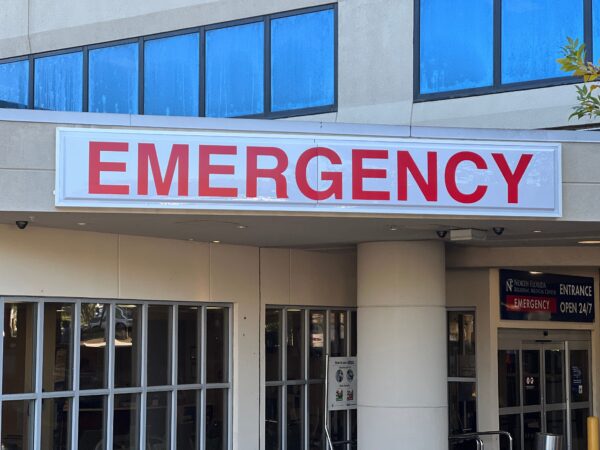
When Marissa Long, a 30-year-old heart transplant recipient, started showing signs of organ rejection, including trouble breathing and falling blood pressure, she did what most people do when they experience a medical emergency: she went to the ER. Unfortunately, there were no treatment spaces available.
Instead, Long spent three days and four nights on a gurney in the hospital hallway near sick patients. “People were coughing and vomiting,” Long told NBC. “I already have a low immune system. I was scared to get sick.” Long’s experience is certainly traumatic, but it’s not unique.
While the ER is meant to provide rapid treatment for urgent wounds, or serve as a gateway for patients admitted to the hospital for longer-term care, several factors, including access to healthcare, availability, convenience, and patient expectations, make the ER the primary place patients receive care. One analysis found that nearly half of all medical treatment occurs in the ER. Longer wait times are an inevitable result.
Long Wait Times are the Rule, Not the Exception
According to the American College of Emergency Physicians, a call for stories about boarding times found that 97 percent of stories cited boarding times of more than 24 hours. Unfortunately, this isn’t a temporary problem. A survey of Minnesota hospitals found that ER backlogs, which became a problem during the recent pandemic, are “becoming a permanent problem,” collectively adding 65,000 more days of inpatient care.
UMass Memorial Health President and CEO Dr. Eric Dickson put the problem in even starker terms, telling Spectrum News, “I’ve practiced emergency medicine in this city for just about 30 years, and I can say without a doubt, we’ve never seen the emergency departments in this city so crowded.”
As Dr. Dickson explains, ER wait times are a “crisis situation.” It impacts all parties and has real consequences for healthcare providers, patients, their families, and even whole communities.
The Consequences of Excessive Wait Times
Increasing ER wait times are partly the result of unresolved staffing issues that have plagued healthcare providers since the COVID-19 pandemic ravaged the industry’s workforce. A New York Times analysis reports that chronic staffing shortage, overworked teams, difficulty recruiting after the pandemic, and frequent surging caseloads often overwhelm the system.
Of course, patients pay the highest price. As The Centers for Medicare & Medicaid Services (CMS) notes, “Long stays in the emergency department before a patient leaves may be a sign that the emergency department is understaffed or overcrowded. This may result in delays in treatment, increased suffering for those who wait, and unpleasant treatment environments.”
Some patients, unwilling to wait, simply leave, forgoing treatment and compounding the costs and healthcare consequences down the road. What’s more, Becker’s Hospital Review reports that nearly half of Americans avoid emergency care in the first place, worried that long wait times and delayed admittance will cost them time, money, and wellness.
Financially, the repercussions can be enormous. The National Library of Medicine estimates that 91 percent of all ER patients waited more than three hours for an inpatient bed, amounting to $204 in lost revenue per patient. With revenue shortage a perennial part of today’s healthcare system, every missed dollar is a meaningful setback that exacerbates the wait time challenge in a self-perpetuating cycle that demands a solution.
Steps Healthcare Providers Can Take to Reduce ER Wait Times
Long ER wait times are a significant problem with many contributing factors. No single solution will serve as a silver bullet, but healthcare providers can take steps to reduce wait times in their ER facilities. While we know that lowering wait times will improve patient care, lower healthcare costs, and support thriving healthcare providers. However, if it were an easy problem to solve, everyone would do it.
Fortunately, there are tangible steps decision-makers can take to move in the right direction. First, healthcare providers need to reduce the number of people in their waiting rooms. Patient education and case management can help. Educate patients about appropriate ER utilization by leveraging digital resources like websites, chatbots, and telehealth.
Meanwhile, healthcare providers must make their treatment rooms available as soon as possible. Unfortunately, the same problems contributing to long wait times make it difficult to quickly clean and disinfect a treatment space.
Increase Room Turn Times in the ER
Fast, effective disinfection accelerates turn times, maximizing treatment space availability. Specifically, automated disinfection technology speeds up this process, enabling highly effective disinfection protocols that protect patients from infectious diseases and help move patients from the waiting room to treatment spaces.
Nevoa’s Stratus handheld fogger, for example, can disinfect an ER room both better and faster than UV disinfection or manual cleaning alone. Powered by hypochlorous acid (HOCl), Stratus kills up to 99.9999 percent of pathogens in just one minute, including Staph, MRSA, and Pseudomonas, the leading causes of HAIs.
Healthcare providers can’t control every element of ER wait times, but they can be exceptional at some things, and that’s enough to improve patient and organizational outcomes.
Faster Patient Care Produce Better Patient Outcomes
Excessive ER wait times are frighteningly normal in 2024, and it’s more than just an inconvenience. It’s a dangerous byproduct of a healthcare system strained beyond capacity.
When patients receive delayed treatment, everyone suffers, depriving them of the care they need and draining healthcare providers of resources they desperately need to offer the very best patient care.
This is where Nevoa can help. With its innovative automated disinfection technology, Nevoa offers healthcare providers a powerful tool to combat one of the critical bottlenecks in patient flow through the ER room turn times.
Contact Nevoa today, and let our team help your ER begin functioning more efficiently and effectively than ever.
